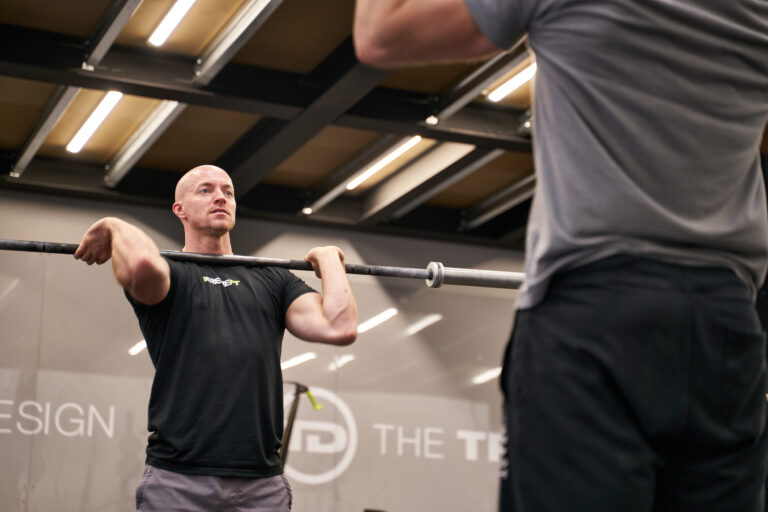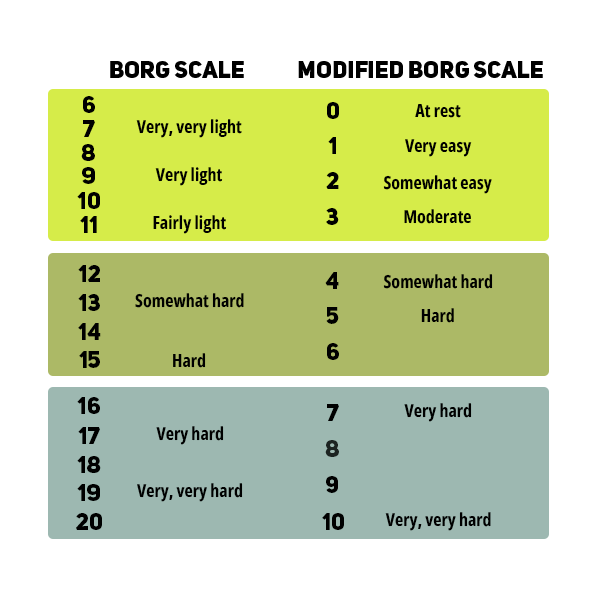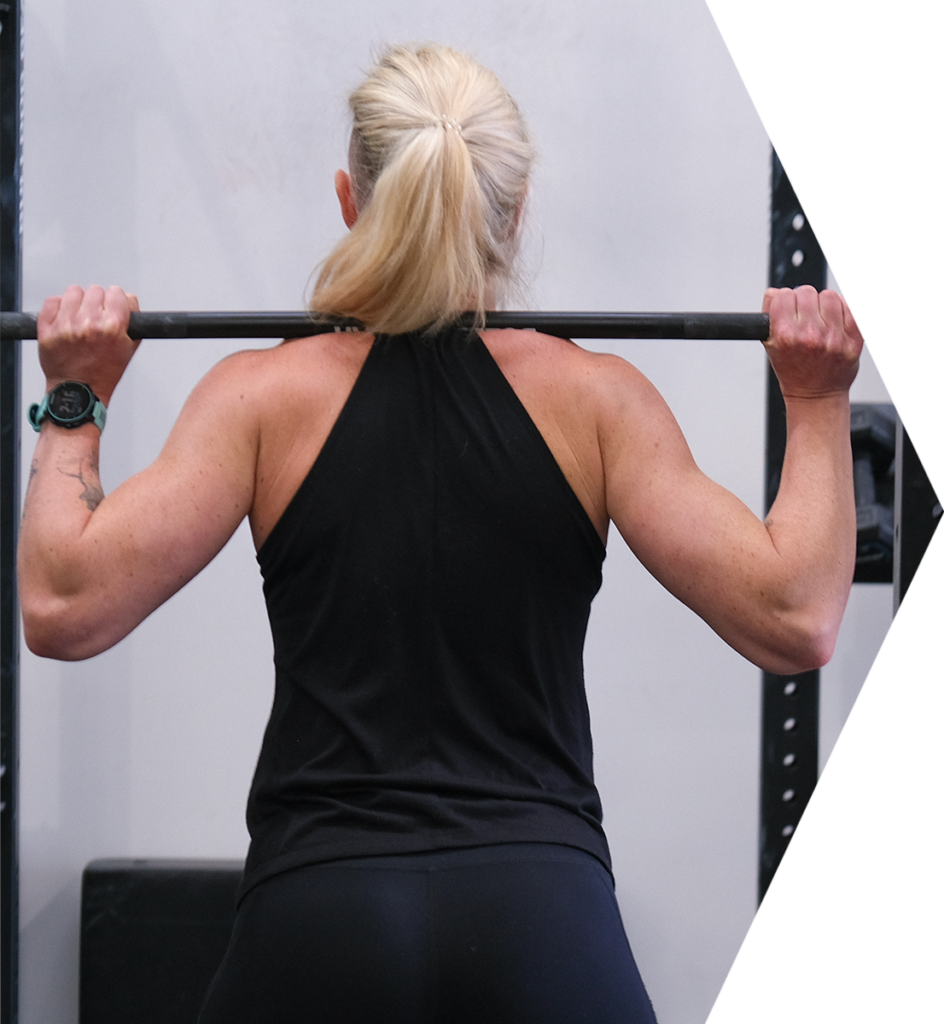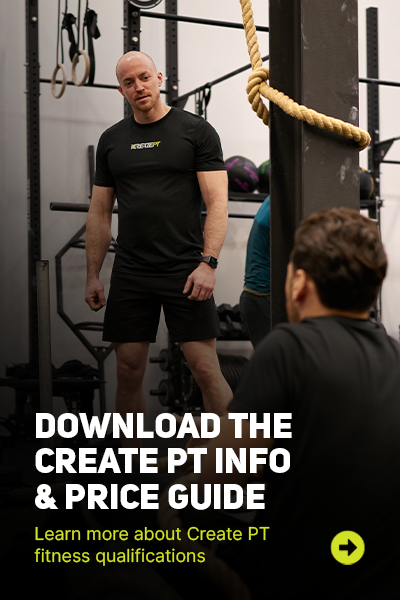Monitoring Exercise Intensity
There are several ways to monitor intensity whilst exercising. As a PT you’ll need to be able to assess the intensity level your client is working at, or explain to them how to gauge their current levels of exertion so they can work to your prescribed intensity levels. There are several ways to monitor intensity, these include the talk test, rate of perceived exertion (RPE), reps in reserve (RIR), heart rate monitoring and percentages of your benchmarks/maximal efforts.
The Talk Test
The Talk Test is a subjective method of assessing exercise intensity. The concept is straightforward: if you can hold a conversation while exercising but can’t sing, you’re likely exercising at a moderate intensity. On the other hand, if speaking full sentences becomes challenging, you’re likely at a high intensity. If you can talk easily with no effort at all, your exercise intensity is probably too low to be significantly beneficial.
Benefits
- Low-Tech and Accessible: One of the main advantages of the Talk Test is that it requires no specialised equipment or training, making it accessible for everyone.
- Real-Time Feedback: The Talk Test gives immediate indications of your current exercise intensity, allowing you to adjust your pace or effort on the go.
- Broad Application: It can be used across a variety of exercise types, from walking and jogging to cycling and group fitness classes.
- Psychological Ease: For beginners or those who may find the idea of ‘high-intensity’ intimidating, the Talk Test can make the process of finding the right exercise intensity less daunting.
- Complementary: The Talk Test can also be used alongside other methods for a more comprehensive understanding of exercise intensity.
Limitations
- Subjective Nature: Your ability to talk can be influenced by various factors like respiratory health, altitude, or even your emotional state.
- Lack of Precision: The Talk Test does not offer precise metrics that can be monitored or recorded over time.
- Individual Variation: Fitness levels can affect how easily someone can talk at different intensities. What may be moderate for one person might be high intensity for another.
- Unsuitable for Certain Activities: In exercises that naturally restrict your ability to talk, like swimming or activities requiring high focus, the Talk Test becomes impractical.
In our personal training course we go into a load more detail on how the talk test and other methods apply to different aerobic training zones such as the increasingly popular zone 2 training.
Rate of Perceived Exertion (RPE)
The Rate of Perceived Exertion (RPE) is a subjective measure of exercise intensity, often expressed on a scale that helps individuals assess how hard they feel they are working during exercise. It’s a widely-used method because it is simple, doesn’t cost anything, and doesn’t require any special equipment.
The Borg Scale and Modified Borg Scale
The Borg Scale is a numerical scale running from 6 to 20, where 6 represents “no exertion,” and 20 signifies “maximal exertion.” The Modified Borg Scale is another version, usually ranging from 0 to 10. Both scales aim to quantify an individual’s level of effort during physical activity.
- Borg Scale: Each number on the Borg Scale is associated with descriptors like “very light,” “somewhat hard,” “hard,” and so on. The numbers are intended to correspond roughly with heart rates whereby you multiply the number on the Borg scale by 10 to get an approximate heart rate; for example, an RPE of 12 should roughly equate to a heart rate of 120 beats per minute.
- Modified Borg Scale: The 0-10 scale is easier to remember and apply. A rating of 0 indicates no effort, while a 10 means maximal effort. This scale does not relate directly to heart rate via a calculation, but is more commonly used due to the simpler numbering system and is based on the individuals subjective feeling of exertion.
Less Effective for Beginners
RPE can be a less effective gauge for exercise intensity for beginners for several reasons:
- Lack of Self-Awareness: Beginners often don’t have a good sense of how hard their bodies are working, making it difficult to accurately assign an RPE value.
- Psychological Factors: New exercisers may feel that any level of exertion is high due to unfamiliarity with the sensations associated with exercise.
- Over or Underestimation: Inaccurate perception can lead to either unsafe levels of exertion or ineffective workouts that don’t yield the desired benefits.
Effectiveness for Cardio and Strength Training
- Cardiovascular Exercise: RPE is often used in cardio training to gauge intensity. For instance, endurance workouts may aim for a lower RPE, while high-intensity intervals may aim for higher RPE levels. It’s useful for adjusting intensity in real-time, especially for those familiar with the sensations associated with different intensities.
- Strength Training: RPE can also be useful in strength training but in a slightly different context. It can be used as a crossover with the reps in reserve method whereby an RPE 8 would mean the individual feels they could do 2 more reps. However this obviously doesn’t account for when you are building to a prescribed weight based on RPE rather than a prescribed number of reps. For example, build to a set of 3 back squats at RPE 8, here the individual would need to be very familiar with how they feel when squatting heavy to achieve a relatively accurate RPE 8. In this case an RPE 8 may work out at around 80-85% of their 1RM back squat.
Advantages and Limitations
Advantages
- Simplicity: No equipment is needed.
- Personalisation: Allows for a subjective measure of intensity tailored to the individual.
- Real-Time Adjustment: Useful for making instant adjustments to workout intensity.
Limitations
- Subjectivity: Can be influenced by mood, sleep, and other factors not directly related to exercise.
- Accuracy: As mentioned, it’s often less accurate for beginners or those not in tune with their bodies.
- Lack of Quantitative Data: Doesn’t provide precise metrics like heart rate or power output, which can be valuable for fine-tuning a training programme.
Overall, RPE is a valuable tool for gauging exercise intensity but should be used selectively, particularly when the individual is not experienced with this method. It’s often most effective when used in conjunction with other methods like heart rate monitoring or % of 1RM.
Reps in Reserve (RIR)
RIR is particularly useful in resistance training, as it is measured by how many reps the individual feels they have left until failure. This makes it a useless measure for cardiovascular training, because it is not rep based, and you are very unlikely to reach absolute failure.
It is however very useful when writing periodised programmes for clients as a way to manipulate the intensity of strength sessions enabling you to strategically vary the workouts throughout the cycle. For example over a 6 week cycle you could reduce the reps in reserve each week culminating in a max effort with 0 reps in reserve prescribed in the final week of the programme.
Reps in Reserve (RIR) can be an effective way to gauge intensity, particularly in the context of strength training. However, it’s not a one-size-fits-all approach and may not be suitable for all types of exercise or for all individuals. Like other measures of intensity, it often works best when used in conjunction with other metrics.
Percentage of Maximal Efforts
This method is another protocol for monitoring intensity more suited to resistance training, it is less useful in a cardiovascular context, but can still be used. Using percentages involves the athlete knowing their maximal effort such as their 1 rep max back squat, or their 100m run time or their FTP score (functional threshold power – a common cycling test to measure power on a bike). You then take that score and use percentages of their maximal effort to dictate the intensity. If the athlete does not know their maximal effort then tests can be performed, we cover a range of these tests later in the course.
Using Percentages in a Cardiovascular Context
You don’t have a 1 rep max with cardio modalities, so working at a % of a specific score or time can be difficult to do. However when working with athletes it can be an effective way to improve event specific performance and to progress a periodised programme with an emphasis on aerobic or anaerobic cardio.
Anaerobic Workouts
- Sprinting and High-Intensity Drills: Anaerobic workouts often involve short bursts of high intensity. Athletes can use a percentage of their maximal sprinting speed or maximal power output in drills to train specific energy systems. For example, doing sprints at 90-100% of maximal speed for short durations targets anaerobic power.
- Plyometrics: For explosive movements like jumps, athletes can consider their maximal jump height or distance and use a percentage of that as a target in training.
- High-Intensity Interval Training (HIIT): In HIIT sessions, athletes can aim for a certain percentage of their maximal effort during work phases. This allows for precise targeting of anaerobic capacity.
Aerobic Workouts
- Long-Distance Running, Cycling, Swimming: Athletes can use a percentage of their maximal aerobic speed or power to guide the intensity of steady-state or interval workouts. For example, running at 70-80% of maximal aerobic speed for extended periods can improve aerobic endurance.
- Heart Rate Zones: While not a direct measure of maximal effort, athletes can also use heart rate zones that are calculated as a percentage of their maximal heart rate. For instance, training at 60-70% of maximal heart rate is generally good for base aerobic conditioning.
- VO2 Max: For a more specific measure, athletes can use a percentage of their VO2 max to guide aerobic workouts. Training at a certain percentage of VO2 max can help improve aerobic capacity effectively.
- Endurance Training: Some athletes use percentages of their maximal time or distance to guide training. For example, a cyclist who knows their maximum distance for a 60-minute time trial can use a percentage of this distance as a target in training sessions.
Integrated Approaches
- Periodisation: Athletes often use a mix of anaerobic and aerobic training, scaling the intensity through percentages of maximal efforts, to achieve peak performance at specific times.
- Cross-Training: An athlete could use percentages in both anaerobic and aerobic modalities to achieve a well-rounded training effect. For example, a triathlete might use percentage-based guidelines for swimming (aerobic), cycling (both), and weightlifting (anaerobic).
- Recovery: On recovery days, athletes could operate at a lower percentage of maximal efforts across both anaerobic and aerobic workouts to allow for recuperation without complete rest.
Using Percentages with Resistance Training
Percentage training in resistance training involves using a calculated percentage of your one-repetition maximum (1RM) to guide your workouts. Here’s a quick summary of how it can be applied:
- Strength Development: For building maximal strength, you might lift weights at 80-90% of your 1RM for lower repetitions (e.g., 3-6 reps per set).
- Hypertrophy (Muscle Size): To focus on muscle size, you’d use a lighter percentage, such as 60-75% of 1RM, and perform higher repetitions (e.g., 8-12 reps per set).
- Endurance: For muscular endurance, you would use an even lower percentage, typically around 50-60% of 1RM, and perform high repetitions (e.g., 15-20+ reps per set).
- Progressive Overload: The percentages can be adjusted upward as you become stronger, ensuring that the training remains challenging and facilitates growth or strength gains.
- Periodisation: In advanced programmes, percentages can change throughout the week or over several weeks to target different training adaptations in a structured way.
- Tracking and Adjusting: Regular testing to update your 1RM or using estimated methods helps to adjust the percentages accurately, making the training more effective.
As with RPE, percentage based training is best with more advanced clients. The main reason for this is beginners usually don’t have a clear understanding of their 1RM for different exercises. The calculation of percentages is dependent on this metric, making it difficult to accurately set training loads.
Another big drawback of % based training is the lack of auto-regulation, fixed percentages do not account for daily fluctuations in performance. Some days you might feel capable of lifting more, and other days less, working off a fixed percentage does not take this into account so could be demoralising or lead to overtraining or fatigue.
Heart Rate Monitoring
Heart rate monitoring is one of the most popular and accessible methods for measuring exercise intensity. By tracking the number of heartbeats per minute (BPM), individuals can gauge whether they are exercising at an appropriate intensity for their fitness goals.
Types of Heart Rate Monitoring Devices
- Chest Strap Monitors: Worn around the chest, these provide highly accurate readings. Products such as Myzone or Polar are ideal for this.
- Wrist-Based Monitors: Often integrated into fitness watches or smartwatches, these are more convenient but can be less accurate. Products such as Apple watch or Garmin.
- Handheld Devices: Devices like pulse oximeters can also provide quick heart rate readings. This includes things like the handles on the treadmill or crosstrainer.
Determining Target Heart Rate Zones
The first step is to determine one’s maximum heart rate (MHR), usually calculated as 220 minus age. Target heart rate zones are then percentages of the MHR. For example:
- Zone 1 (50-60% of MHR): Warm-up or cool-down
- Zone 2 (60-70% of MHR): Fat-burning & endurance
- Zone 3 (70-80% of MHR): Aerobic exercise
- Zone 4 (80-90% of MHR): Anaerobic exercise
- Zone 5 (90-100% of MHR): Maximum effort
Application to Different Types of Workouts
- Aerobic Workouts: Staying in Zones 2 and 3 helps to improve cardiovascular endurance.
- Anaerobic Workouts: For high-intensity interval training (HIIT) or sprints, reaching Zones 4 and 5 for short periods is ideal.
Benefits
- Accuracy: Provides a relatively accurate measure of exercise intensity in real-time.
- Individualisation: Can be customised to an individual’s current level of fitness.
- Versatility: Applicable to many types of exercise, from jogging to high-intensity workouts.
- Data Tracking: Enables long-term data collection for trend analysis and performance tracking.
Limitations
- Environmental Factors: Heat, humidity, and altitude can affect heart rate independently of exercise intensity.
- Cardiac Drift: Heart rate can gradually increase during sustained exercise without a corresponding increase in effort, known as cardiac drift.
- Medical Conditions: Heart medications, caffeine, and other conditions can affect heart rate.
- Initial Cost: Quality heart rate monitors can be expensive.
- Learning Curve: Understanding how to interpret and act upon heart rate data can take time.









